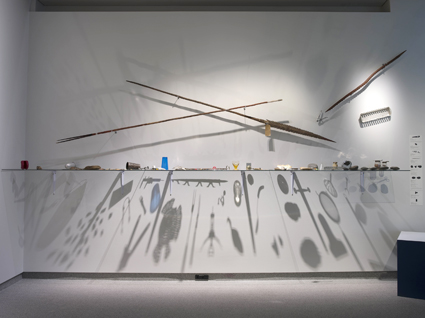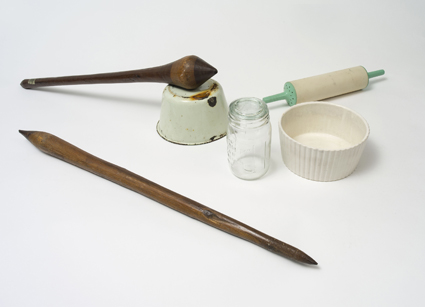A world made into tools
Greg Hooper: Gapuwiyak Calling; written on the body

Written on the body, University of Queensland Anthropology Museum
photo Carl Warner
Written on the body, University of Queensland Anthropology Museum
Two exceptional exhibitions at the University of Queensland Anthropology Museum both involve relations between Aboriginal and Torres Strait Islander people and their artefacts and the artefacts associated with European Australia—mobile phones, kitchen tools, hunting tools, potato mashers, shields. Visit and visit again.
Gapuwiyak Calling is a fascinating presentation of Yolngu people (mainly Gapuwiyak community, Arnhem Land) talking about and showing how they’ve used mobile phones as media devices since 3G arrived there in 2008. The standout for me is where the Yolngu have taken ringtones, ditched the defaults, and made them their own as a signal of place and family relations.
“This is a song by my mother-in-law’s brother, especially beautiful as it is a clan funeral song,” says a woman speaking of her ringtone as a moment for deep feeling and sorrow. A young man listens to his favourite band “all the time to feel good,” another to the call of the Green Frog, another to a clan song from a circumcision ceremony, yet another to a ceremony with her father singing. He’s been dead 12 years, she misses him—the ringtone reminds her of him and fills her with sadness.
The oft expressed use of ringtones as triggers for sadness, concern and worry about family is perhaps the most surprising aspect of the show. Contrast with mainstream (Anglo/Euro) culture, where sorrow and worry are emotions to avoid, quasi-taboo, indications of failure in emotional control. For the Yolngu in this exhibition sorrow and worry about family are embraced directly and honestly.
Similarly for the old-style home-movie directness of the short phone videos of kids dancing, the grandpa and grandson going out fishing in the tinny, man and boy using in-camera edits to make a little magic show to send to friends and family. This relatively direct expression of lived experience is now almost impossible to achieve in places where mainstream media dominates the flow of information with non-local imagery and a hubris that can even stake a claim to reality as a genre.

Written on the body, University of Queensland Anthropology Museum
photo Carl Warner
Written on the body, University of Queensland Anthropology Museum
The other exhibition entitled Written on the body, is a collaborative work from artist Judy Watson and the Director of the UQ Anthropology Museum, Diana Young. It is an astonishingly layered, gentle, subtle and visually sophisticated exhibition combining Aboriginal and Torres Strait Islander material culture with well used household kitchenware of the modern suburban era—the toolkits of everyday life spanning the last hundred years or more. Objects are beautifully arranged in small groupings on the wall, on plinths, in “museum quality” cabinets, or on a glass shelf, casting shadows below and along the gallery wall.
Relations within the groupings might be visual (a cylindrical grater next to a club garnished with old hand-forged nails), functional (a clear glass tumbler and a bailer shell) or both visual and functional—pink silicon ice cube tray next to a flat tray-like rock, both having hemispherical depressions for holding whatever the person wants held.
Collected in the early part of the 20th century, almost all the Aboriginal and Torres Strait Islander objects were stripped of their particulars and written on during the collection process. While the show has an underlying critique of this colonial naming and claiming, stripping objects of their social relations not only dehumanises them, but also transforms the objects into signifiers of universal embodiment and through this universality colonial practice speaks against itself.
We see two shields and an aluminium teapot clumped together on the wall—they have handles: the handles are the same in size, the same in shape, the same in ‘graspability.’ A potato masher is placed next to a smooth, graspable rock, both are objects through which the body acts upon the world to pound and soften starchy foods. Such is the underlying humanity of the show, that all bodies across all time are the same body with the same functionality. Stripped of their particulars, of the relation between maker, owner and user, the objects end up not as ‘your’ object but as ‘our’ object, part of the common human heritage of building a toolkit that is fit for purpose, part of the transformation of the world into graspable, scrapable, heftable tools. Needs and goals acting into the world through a world made into tools. By us. For us. Always and everywhere.
Gapuwiyak Calling, curator Miyarrka Media in association with the UQ Anthropology Museum; Written on the body, curators Judy Watson, Diana Young; University of Queensland Anthropology Museum, Brisbane, 15 March-15 Aug
RealTime issue #121 June-July 2014 pg. 48






